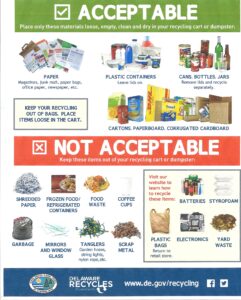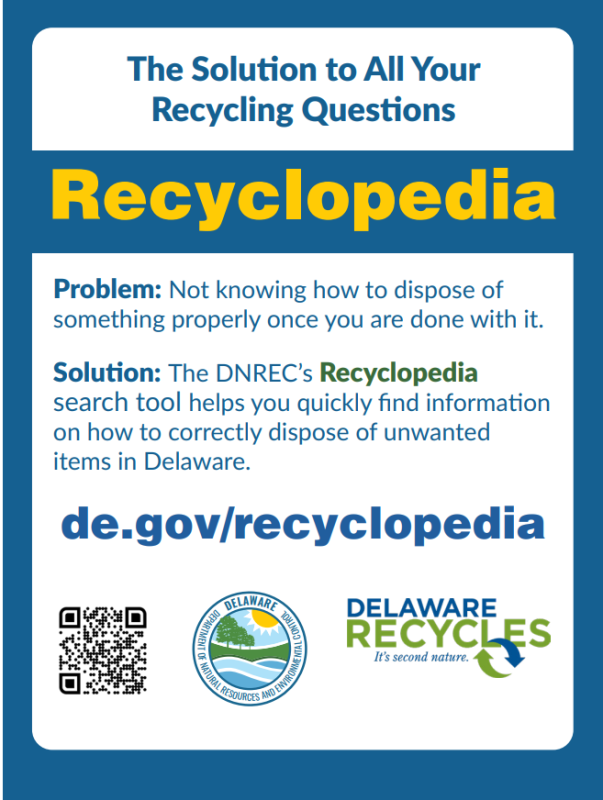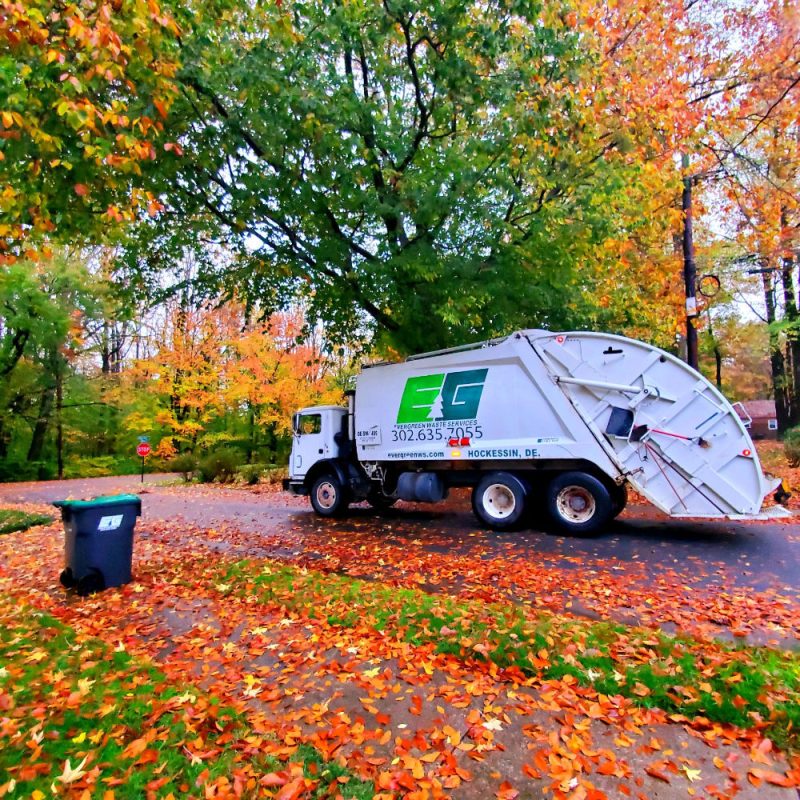Evergreen provides weekly collection of trash, recycle, yard Waste and bulk Items on the same day of the week.


Unsure of what to recycle? Try out our new recycle tool, de.gov/recyclopedia

Recycling
Participation is encouraged with our once a week recycling program. We do “single stream recycling” meaning everything goes into one container and is sorted out at the recycling facility. Yes, this really happens.
To see a recycling facility in action please watch the video below.
Evergreen Waste Services would like everyone to reduce, reuse and recycle. We pick unlimited recyclables so feel free to put out as many of these approved materials. We provide you with a container and collection weekly on the same day as your garbage pick up. This service is included with your rate and it’s encouraged that you recycle. Remember even if you just recycle your paper and glass that’s better than having it go to the landfill.
If you’re interested in where we take your material click on the link below. Delaware has invested a lot of resources to have a good recycling program for its residents and we want to support their efforts.
http://dswa.com/facilities/the-delaware-recycling-center/
Yard Waste
Here are a few options for you to take care of your yard waste.
In 2007 the State of Delaware passed into law a yard waste ban at the Cherry Island landfill. According to Delaware law and the Delaware State Waste Authority (DSWA) we are not allowed to co-mingle yard waste with your household trash.
- Evergreen has a service where we come every week to pick up your yard waste.
- Same day as your trash and recycling pick-up.
- You may pay yearly, which includes a free Christmas tree pick-up or pay for the quarter you choose.
- We will take grass clippings, leaves, shrubs, weeds, and small tree branches. Please bag these items or you can put them loose in a container.
- Tree limbs and brush must not be any longer than 3ft and 1 inch in diameter and tied into bundles, bagged, or canned to help our drivers avoid having to pick up every individual stick.
In addition, New Castle County has drop off sites that you can take your yard waste to for no cost. These sites are run by Delaware Department of Natural Resources and Environmental Care (DNREC).
http://www.dnrec.delaware.gov/yardwaste/pages/default.aspx

Composting
Evergreen Waste services has no issues picking up your yard waste, but our feelings are not hurt if you decide to take matters into your own hands when it comes to creating your own compost. Below are some methods that we have compiled to assist you in this process. If you have any additional ideas that you have found to make this process better we would love to hear about it.
Email us at [email protected] We appreciate all those that strive to reduce, reuse and recycle.
Why Compost?
Compost is the single most important supplement you can give your garden soil. ??Composting is a simple way to add nutrient-rich humus which fuels plant growth and restores vitality to depleted soil. It’s also free, easy to make and good for the environment.
Benefits of Composting
Soil conditioner. With compost, you are creating rich humus for lawn and garden. This adds nutrients to your plants and helps retain moisture in the soil.
Recycles kitchen and yard waste. Composting can divert as much as 30% of household waste away from the garbage can.
Introduces beneficial organisms to the soil. Microscopic organisms in compost help aerate the soil, break down organic material for plant use and ward off plant disease.
Good for the environment. Composting offers a natural alternative to chemical fertilizers.
Reduces landfill waste. Most landfills in North America are quickly filling up; many have already closed down. One-third of landfill waste is made up of compostable materials.
What to Compost
You can also add garden soil to your compost. A layer of soil will help to mask any odors, and micro-organisms in the soil will accelerate the composting process.
Do not compost meat, bones or fish scraps (they will attract pests), perennial weeds (they can be spread with the compost) or diseased plants. Do not include pet manures in compost that will be used on food crops. Banana peels, peach peels and orange rinds may contain pesticide residue, and should be kept out of the compost. Black walnut leaves should not be composted. Sawdust may be added to the compost, but should be mixed or scattered thinly to avoid clumping. Be sure sawdust is clean, with no machine oil or chain oil residues from cutting equipment.
For kitchen wastes, keep a large plastic container with a lid and a handle under the sink. Chop up any large chunks before you toss them in. When the container is full, then empty it into the compost pile. This reduces the number of trips you’ll have to make.
With yard and garden wastes, different composting materials will decompose at different rates but they will all break down eventually. If you want to speed up the composting process, chop the larger material into smaller pieces. Leaves and grass clippings are also excellent for compost, but should be sprinkled into the bin with other materials, or put on in thin layers. Otherwise they will mat together and take longer to compost.
How to Compost
- Start you compost pile on bare earth. This allows worms and other beneficial organisms to aerate the compost and be transported to your garden beds.
- Lay twigs or straw first, a few inches deep. This aids drainage and helps aerate the pile.
- Add compost materials in layers, alternating moist and dry. Moist ingredients are food scraps, tea bags, seaweed, etc. Dry materials are straw, leaves and wood ashes. If you have wood ashes, sprinkle in thin layers, or they will clump together and be slow to break down.
- Add manure, green manure ( clover, buckwheat, wheatgrass ) or any nitrogen source. This activates the compost pile and speeds the process along.
- Keep compost moist. Water occasionally, or let rain do the job.
- Cover with anything you have – wood, plastic sheeting, carpet scraps. Covering helps retain moisture and heat, two essentials for compost. Covering also prevents the compost from being over-watered rain. The compost should be moist, but not soaked and sodden.
- Turn. Every few weeks give the pile a quick turn with a pitchfork or shovel. This aerates the pile. Oxygen is required for the process to work, and turning “adds” oxygen. You can skip this step if you have a ready supply of coarse material, like straw. (See below)
Carbon/Nitrogen Ratio
All compostable materials are either carbon or nitrogen-based. The secret to a healthy compost pile is simple: maintain a working balance between these two elements.
Carbon – carbon-rich matter (like branches, stems, dried leaves, peels, bits of wood, bark dust or sawdust, shredded brown paper bags, coffee filters, conifer needles, egg shells, hay, peat moss, wood ash) gives compost its light, fluffy body.
Nitrogen – nitrogen or protein-rich matter (manures, food scraps, leafy materials like lawn clippings and green leaves) provides raw materials for making enzymes. A healthy compost pile should have much more carbon than nitrogen. A simple rule of thumb is to use one-third green and two-thirds brown materials. This allows oxygen to penetrate and nourish the organisms that reside there. Too much nitrogen makes for a heavy, smelly, slowly decomposing mass. Good composting hygiene means covering fresh nitrogen-rich material, which can release odors if exposed to open air, with carbon-rich material, which often exudes a fresh, wonderful smell. If in doubt, add more carbon!
Simplest Composting Methods
The biggest chore with composting is turning the pile from time to time. However, with ‘no-turn composting’, your compost can be aerated without turning.
The secret is to thoroughly mix in enough coarse material, like straw, when building the pile. The compost will develop as fast as if it were turned regularly, and studies show that the nitrogen level may be even higher than turned compost.
With ‘no-turn’ composting, add new materials to the top of the pile, and harvest fresh compost from the bottom of the bin.
Composting leaves
If you have too many leaves to incorporate into the compost bin, you can simply compost the pile of leaves by itself. Locate the pile where drainage is adequate; a shaded area will help keep ?The leaf pile should be at least 4′ in diameter and 3′ in height. Include a layer of dirt between each foot of leaves. The pile should be damp enough that when a sample taken from the interior is squeezed by hand, a few drops of moisture will appear. The pile should not be packed too tightly.
The pile will compost in 4 – 6 months, with the material being dark and crumbly. Leaf compost is best used as an organic soil amendment and conditioner; it is not normally used as a fertilizer because it is low in nutrients.
Leaf-mould tea
You can also use leaves to make a nutritious “tea” for your plants. Simply wrap a small pile of leaves in burlap and immerse in a garbage can or large bucket of water. Leave for three days, then remove the “tea bag” and dump contents into the compost. Scoop out the enriched water with a smaller bucket and use to water your plants and shrubs.
Enclosed Compost Bin
For small-scale outdoor composting, enclosed bins are an option. The least expensive method is to build one yourself from a large garbage can. Simply drill 1.5-cm aeration holes in rows at roughly 15-cm intervals around the can. Fill the can with a mixture of high-carbon and high-nitrogen materials. Stir the contents occasionally to avoid anaerobic pockets and to speed up the composting process. If the lid is secure, the bin can be laid on its side and rolled; a length of 2″ cedar ( use a 2×2 or a 2×4) can bolted to the inside, running top to bottom, to help flip the material. Otherwise the contents tend to stay in place while the bin is rolled.
Another option is a semi-enclosed bin. A trade name for this is compost digester. These bins are enclosed on the sides and top, and are open on the bottom so they sit directly on the ground. These are among the most common composting units for homes in residential areas where bins tend to be smaller, yet enclosed enough to discourage pests. These bins are inexpensive, but it is difficult to turn the compost, so it can take several months to produce compost. These bins are thin-walled plastic, and may chip along the edges, especially during a freeze.
The most efficient enclosed bin method is the drum/tumbler system. It’s possible to maintain relatively high temperatures in drum/tumbler systems, both because the container acts as insulation and because the turning keeps the microbes aerated and active. An interior “paddle” aids aeration and prevents clumping of the composting materials. This greatly speeds up the composting process.
An enclosed ‘tumbler’ system offer the following benefits:
- speeds up the composting process
- can compost year-round, due to higher internal temperature
- reduces or eliminate odors, pest proof
- keeps compost neatly enclosed, well-suited for residential areas
Tips for successful composting
Activate your compost.
‘Activators’ can be added to your compost to help kick-start the process and speed up composting. Common compost activator materials are: comfrey leaves, grass clippings, young weeds, well-rotted chicken manure.
Flying insects attracted to your compost?
Small fruit flies, especially, are naturally attracted to the compost pile. They can be discouraged by simply covering any exposed fruit or vegetable matter. Keep a small pile of grass clippings next to your compost bin, and when you add new kitchen waste to the pile, cover it with one or two inches of clippings. Adding lime or calcium will also discourage flies.
Unpleasant odors from your compost pile?
This can be a concern in urban and suburban areas with small lots and neighbors living close by. Odors can be reduced, or eliminated, by following two practices: first, remember to not put bones or meat scraps into the compost; second, cover new additions to the compost pile with dry grass clippings or similar mulch. Adding lime or calcium will also neutralize odors. If the compost smells like ammonia, add carbon-rich elements such as straw, peat moss or dried leaves/.
Is your compost pile steaming?
No problem. A hot, steamy pile means that you have a large community of microscopic critters working away at making compost.
Matted leaves, grass clipping clumping together?
This is a common problem with materials thrown into the composter. The wet materials stick together and slow the aeration process. There are two simple solutions: either set these materials to the side of the composter and add them gradually with other ingredients, or break them apart with a pitchfork. Grass clippings and leaves should be mixed with rest of the composting materials for best results.
Problems with raccoons?
If there’s a population of raccoons in your area, they will be naturally attracted to your compost pile. The best solution to this problem is to bar their entry to the compost. (Traps and poisons are usually more trouble than they’re worth.) A wood or metal lid can be easily hinged to the bin described above on this page, or you can buy a commercially-made compost bin with secure fitted lids which are pest-proof.
A moveable feast.
The soil beneath a compost bin becomes enriched as nutrients filter down with successive watering. You can place your bin on a plot of earth which you plan to use for a future vegetable or flower bed, or fruit tree. Each year, you can move the bin to a different area; you’ll get a double benefit – the compost from the bin, and a bed of nutrient-rich soil ready for new plantings.
Additive only.
Compost should be used as a soil additive, and not as the 100% growing medium.
Take advantage of autumn’s bounty.
The biggest challenge for small-scale backyard composting is finding enough carbon-rich materials to balance the regular input of nitrogen-rich materials which come from kitchen scraps, fruit and vegetable peelings, coffee grounds, grass clippings and other fresh materials.
